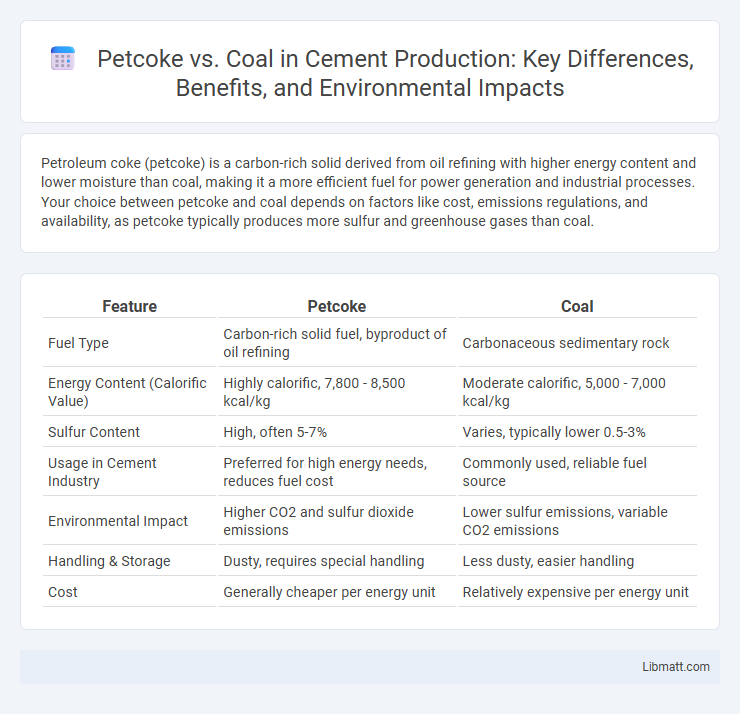Petroleum coke (petcoke) is a carbon-rich solid derived from oil refining with higher energy content and lower moisture than coal, making it a more efficient fuel for power generation and industrial processes. Your choice between petcoke and coal depends on factors like cost, emissions regulations, and availability, as petcoke typically produces more sulfur and greenhouse gases than coal.
Table of Comparison
| Feature | Petcoke | Coal |
|---|---|---|
| Fuel Type | Carbon-rich solid fuel, byproduct of oil refining | Carbonaceous sedimentary rock |
| Energy Content (Calorific Value) | Highly calorific, 7,800 - 8,500 kcal/kg | Moderate calorific, 5,000 - 7,000 kcal/kg |
| Sulfur Content | High, often 5-7% | Varies, typically lower 0.5-3% |
| Usage in Cement Industry | Preferred for high energy needs, reduces fuel cost | Commonly used, reliable fuel source |
| Environmental Impact | Higher CO2 and sulfur dioxide emissions | Lower sulfur emissions, variable CO2 emissions |
| Handling & Storage | Dusty, requires special handling | Less dusty, easier handling |
| Cost | Generally cheaper per energy unit | Relatively expensive per energy unit |
Understanding Petcoke and Coal: Key Definitions
Petroleum coke (petcoke) is a carbon-rich solid derived from oil refining, characterized by higher energy content and sulfur levels compared to coal. Coal is a naturally occurring fossil fuel formed from plant remains, primarily used for electricity generation and industrial processes due to its variable carbon composition. Understanding these key definitions highlights petcoke's role as an alternative fuel with distinct chemical properties and environmental considerations compared to traditional coal.
Composition and Chemical Differences
Petroleum coke (petcoke) primarily consists of high carbon content, low sulfur, and minimal ash compared to coal, which contains varied carbon levels with higher volatile matter and moisture. Chemically, petcoke has a higher calorific value due to its dense carbon structure and lower oxygen content, resulting in more efficient combustion. Coal's heterogeneous composition includes complex organic molecules with oxygen, hydrogen, sulfur, and nitrogen, causing more impurities and emissions during burning.
Energy Content and Efficiency Comparison
Petroleum coke (petcoke) typically has a higher energy content than coal, with calorific values ranging from 7,500 to 8,500 kcal/kg compared to coal's 5,000 to 7,000 kcal/kg, making petcoke a more energy-dense fuel. Efficiency-wise, petcoke burns hotter and longer, which can improve thermal efficiency in power plants but may require specialized handling due to its higher sulfur and metal content. Understanding these differences helps optimize Your fuel choice based on energy needs and environmental considerations.
Environmental Impact: Emissions and Pollution
Petcoke produces higher levels of carbon dioxide, sulfur dioxide, and nitrogen oxides compared to coal, contributing to increased greenhouse gas emissions and acid rain. Its combustion releases more heavy metals and particulate matter, leading to severe air quality deterioration and health risks. Understanding these emissions helps you make informed decisions about your energy sources and their environmental consequences.
Industrial Applications and Uses
Petcoke is widely used in cement production, steel manufacturing, and power generation due to its high carbon content and energy density, making it an efficient fuel and reducing reliance on traditional coal. Coal remains a primary energy source for electricity generation and is essential in metallurgical processes, particularly coke production for blast furnaces in steelmaking. Both fuels support industrial applications but petcoke's lower ash and sulfur content offer advantages in specific sectors like cement kilns and industrial boilers.
Availability and Global Production
Petroleum coke (petcoke) production is closely tied to global oil refining volumes, with major producers including the United States, China, and India, where abundant crude oil refining generates significant petcoke supplies. Coal remains more widely available worldwide, with the largest producers being China, India, the United States, and Australia, due to extensive coal reserves and mining infrastructure. While coal's production volume exceeds petcoke globally, petcoke availability depends heavily on oil market dynamics and refinery output, influencing regional supply variations.
Cost Analysis: Petcoke vs Coal
Petroleum coke (petcoke) is generally cheaper than coal due to its status as a refinery byproduct, with prices often 20-30% lower than standard thermal coal. Despite lower costs, petcoke requires additional expenses related to handling and emissions control because of its higher sulfur and metal content. The total cost analysis must balance petcoke's lower fuel price against increased environmental compliance and transportation fees.
Regulatory and Policy Considerations
Petcoke and coal face distinct regulatory and policy frameworks due to differences in environmental impact and emissions profiles. Petcoke typically has higher sulfur content leading to stricter air quality regulations and potential restrictions under clean air acts, while coal regulations often focus on mercury, particulate matter, and carbon emissions. Your compliance strategy must account for regional policies, emission limits, and fuel quality standards to ensure regulatory adherence and optimize operational sustainability.
Handling, Storage, and Transportation
Petcoke and coal differ significantly in handling, storage, and transportation due to their physical and chemical properties. Petcoke's fine powder form requires specialized containment to prevent dust emissions and poses higher fire and explosion risks than coal's bulkier, more stable lumps. Ensuring your infrastructure can safely manage petcoke's abrasive and potentially hazardous nature is crucial for efficient and compliant fuel logistics.
Future Outlook: Trends in Fuel Choices
Petcoke and coal face shifting demand due to environmental regulations and the global push for cleaner energy sources, with many industries moving toward low-sulfur alternatives and renewable fuels. The future outlook favors fuels with lower carbon emissions, prompting companies to invest in technologies that can capture or reduce pollutants from petcoke and coal usage. Your fuel choices will increasingly depend on sustainability goals and compliance with stricter international environmental standards.
Petcoke vs Coal Infographic

 libmatt.com
libmatt.com